
views
Boiling Eggs Properly
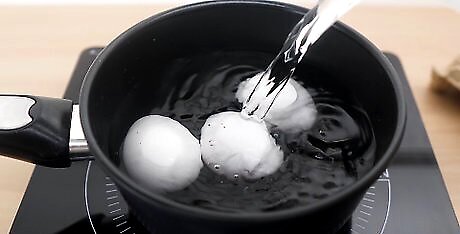
Cover raw eggs with cold water. Take however many raw eggs you want to boil and put them in a heavy-bottomed pot. Gently, fill the pot with cold water, taking care not to jostle the delicate eggshells too much. Use enough to cover the eggs by about an inch. Put the pot, uncovered, over medium-high heat and bring it to a boil. Never add raw eggs to boiling water. Boiling the water first results in the most inconsistent cooking process, often ending with broken shells, leaky eggs, and greenish yolks. Bringing the eggs up to temperature slowly ensures even cooking.
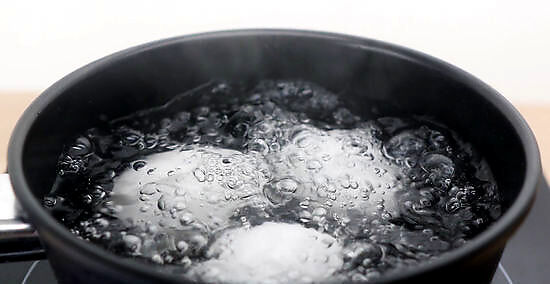
Turn off the heat as soon as the water boils. Depending on how you want your eggs cooked, you can remove the egg at different times in the process, but the easiest to remember and the most sure way to cook eggs, however, is to remove the pot from the heat just after it reaches a boil and leave the eggs in the water until the water cools. Boiled this way, you can be confident the eggs are hard-boiled and solid: Add eggs to cool water and heat to boiling over medium-high heat Remove the water from the heat as soon as it boils Cover the pot with a lid Let the eggs sit for 15 minutes, or until the water becomes cool enough to dip a finger in
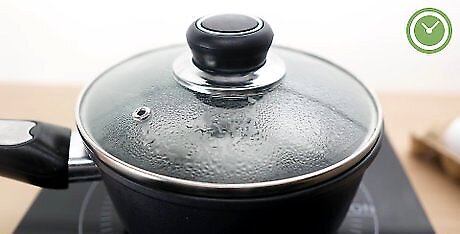
Watch the clock for more specific yolks. If you want a softer-boiled egg, or you want to eat more quickly, you can remove the eggs from the simmering water after a variable amount of time has elapsed. If you want to do this, turn the heat down slightly, to about medium, when the water reaches a boil, and start watching the clock. For soft-boiled eggs, remove after 2 minutes. The whites should be cooked thoroughly, and the yolks should still be somewhat runny. Rinse immediately in cold water to stop the cooking process, or they'll become quickly over-done. For medium-boiled eggs, remove after 4 1/2 minutes. The yolks of medium-eggs should be just about solid, but moist, more like a custard than a hard-cooked egg. For hard-boiled eggs, remove after 8 minutes. The yolks of hard-boiled eggs are crumbly and bright yellow, completely solid, but with none of the grayish-green around the yolk that over-cooking yields.

Consider adding salt or vinegar to the water. It's a common misconception that adding salt to water will raise the boiling point and result in a more uniform boil, or will make the egg easier to peel. It is true, however, that adding salt will season the water, affecting the flavor (even in hard boiled eggs), but you'd need to add an irrational amount of salt (about a half-cup) to raise the temperature even a few degrees. Adding about a teaspoon of vinegar, however, will help to keep the white intact, should the shell crack any during the boiling process, without affecting the flavor significantly. Consider adding a small amount to keep your eggs solid.

Simmer, don't boil. Greenish or grayish rings around the yolk are a telltale sign that you've boiled the egg either at too-high a temperature, possibly by dropping it directly into boiling water, or that you cooked it for too long. To avoid this, don't cook eggs at a rolling boil, but turn it down to about medium temperature, cooking them at a quick simmer. There should still be bubbles, but not so many that the eggs jostle around and rattle the pot. The green-gray color results from iron in the egg yolk interacting with sulphur in the white, and only happens when they react at high temperature. You'll never reach that high temperature if you bring the eggs up gradually and remove them from the heat in time. Avoid green yolks with proper technique. "I never understood why my hard-boiled eggs got that unappetizing green ring around the yolks. This article explained it's caused by overcooking at too high a temperature. Now that I know to simmer the eggs gently and remove them from the heat on time, I can avoid those greenish-gray yolks." - Stephanie B. Gain confidence boiling eggs. "I always struggled with boiling eggs — never knowing when to start timing or how long to boil them. This article's step-by-step instructions gave me the knowledge I lacked. From start to finish, it showed me exactly how to boil eggs properly. Now, I can make the perfect boiled eggs with total confidence every time." - Meshia Elsenpeter Prepare an egg sandwich independently. "I wanted to make an egg and cress sandwich while my mom was out, but I didn't know how to boil an egg on my own yet. This article taught me the whole process from start to finish. Now, I feel ready to boil eggs myself so I can prepare sandwiches independently." - Chloe W. Identify when eggs are truly done. "Every time I've tried making hard-boiled eggs in the past, they were still runny when I cracked them open. This article showed me foolproof ways to test doneness, like spinning the egg. Now, I can easily tell when my eggs are fully hard-boiled with no uncertainties." - Ariel Doyle (wikiHow Community Member) We want to hear from you! Advice from our readers makes our articles better. If you have a story you’d like to share, tell us here.
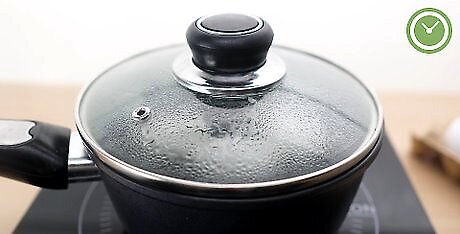
Use the slow cool-down if you lost track of time. If you added your eggs to boiling water, or haven't been watching the clock, don't fear. Make sure they've been in the water for at least 5 minutes, and them cover the pot and remove them from the heat. Wait 10 minutes and they'll be done every time.
Testing the Eggs
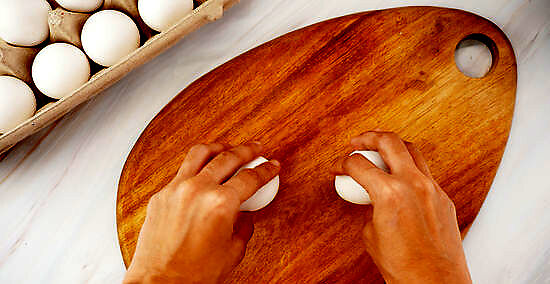
Spin the egg. The quickest way to distinguish between an uncooked egg and a solid boiled egg is to put it flat on the counter and spin it. A raw egg will wobble and spin slowly, because it's filled with liquid, while a boiled egg will spin very quickly and very easily. Try this now by getting out a raw egg and trying to spin it like a top, on the flat side of the shell. Compare that to an egg you know is done and you'll have an easy quick test to distinguish between them every time.
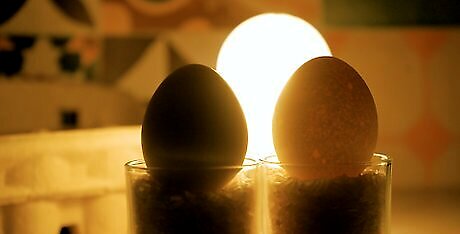
Hold the egg up to the light. Another easy way to distinguish between uncooked eggs and solid eggs is to hold it up to the light. The thin shell of a raw egg should let some light through, and you'll be able to see the yolk on the inside. A boiled egg will be completely solid. Use a flashlight on the other side of the egg and shine it toward you, holding the egg between the light and your eyes. Move it back and forth slightly while you look for the yolk.
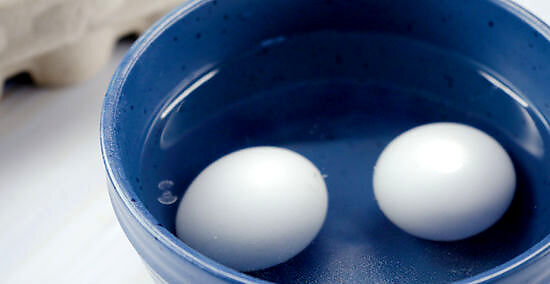
Drop the egg in warm water and look for bubbles. If an egg is raw, tiny air bubbles will rise from the shell as soon as its submerged in water. If it's in the warm boil, it'll be hard to tell because the water itself will be bubbling. But keeping an eye on the bubbles that rise from the egg itself is a good fast way to tell whether the egg is raw or cooked.
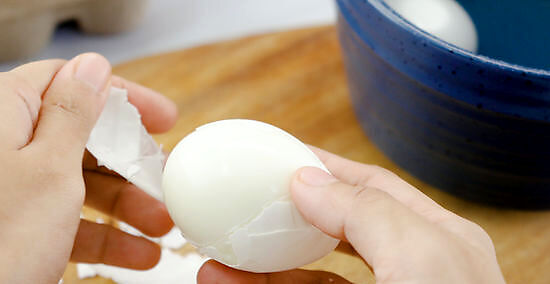
Crack it open, if all else fails. If you're boiling multiple eggs and you're still not sure how to figure out whether or not they're done, take one out, run it under water, and crack it open quickly to check. Cut it in half and examine the yolk. If it's where you want it to be, take the rest of the eggs out. If not, leave them in for another few minutes. You'll only have sacrificed one and you won't be wondering.
















Comments
0 comment